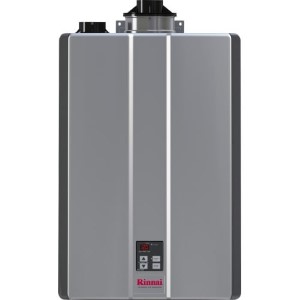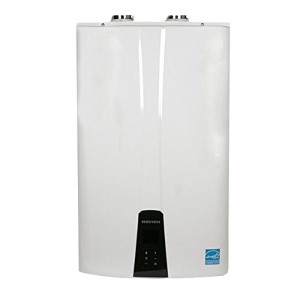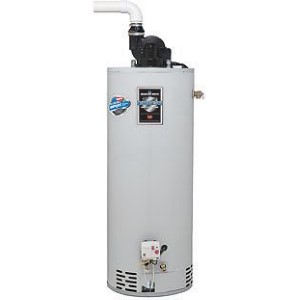- Home
- Tankless water heaters
Tankless Water Heaters: The Smart Way to Heat Water in Your Home
 Rinnai tankless
Rinnai tanklessBuying or upgrading to a tankless water heater is a significant step towards enhancing your home's efficiency and comfort.
Our guide is tailored to help you navigate this process with ease. It includes comprehensive reviews of the top models available, breaking down their advanced features to aid in your decision-making.
We also provide a detailed analysis of the advantages and disadvantages of tankless systems, ensuring you have a well-rounded understanding before making a choice.
Selecting the right tankless size for your needs is crucial, and our guide offers insights to assist you in this aspect.
Additionally, we cover essential topics like installation procedures, maintenance tips, and strategies for maximizing energy savings.
With this guide, you'll have all the information necessary to confidently choose, install, and maintain a tankless water heater, making your home more energy-efficient and comfortable.
Tankless water heaters offer a host of advantages for modern living. Compact yet efficient, these units utilize on-demand technology to supply hot water exactly when it's required, eliminating the limitations of a finite tank.
Their innovative approach not only guarantees rapid delivery of hot water but also contributes to significant energy savings.
With such features, tankless water heaters enhance overall comfort and convenience in any household, aligning with the evolving needs of energy-conscious and space-saving home designs.
Tankless water heaters: Things to consider
- Best brands
- Advantages
- Disadvantages
- Tankless vs. tank
- Types
- Manufacturers
- Buying tips - what to look for
- Sizing
Top tankless water heaters brands
Advantages of tankless gas water heaters
 Takagi T-H3 tankless water heater
Takagi T-H3 tankless water heaterTankless water heaters offer numerous advantages over standard storage tank-type models.
On-demand heating: Unlike conventional tank-type heaters, which heat water continuously even when not in use (e.g., during the night, when away from home, or on vacation), tankless heaters heat water on demand. This means hot water is always clean and fresh, without the issues of rust and scale buildup inside the tank, resulting in reduced maintenance.
Endless supply: Tankless hot water heaters provide a continuous flow of hot water while keeping energy consumption and greenhouse gases low. They are ideal for large families, homes with small children, or those requiring a lot of hot water, such as when filling a hot tub. Although often referred to as instantaneous, they don’t provide instant hot water. For quicker delivery, consider a model with a recirculation system, either internal or external..
Versatile: Tankless gas water heaters are adaptable for indoor or outdoor use. Due to their compact size, they can be wall-mounted, saving valuable floor space. They typically employ direct and power vent system for efficient and safe removal of flue gases.
Energy savings: By upgrading to a tankless water heater, homeowners can significantly reduce standby heat loss and cut energy consumption by up to 30%. These highly efficient, often Energy Star compliant systems, are a smart choice for eco-conscious living.
Precise temperature control: Tankless models provide exact temperature settings, offering consistent and comfortable hot water for bathing, cooking, or cleaning.
Quality elements: Top tankless water heaters from brands like Noritz, Rinnai, or Takagi, feature advanced, commercial-grade elements and sophisticated controls with self-diagnostic programs for easy troubleshooting.
Most components are replaceable, enhancing longevity, with many models lasting up to 20 years.
High demand capability: Contrary to the belief that tankless heaters are only for point-of-use applications, models like the; Noritz NRC1111 can deliver up to 11 GPM, and some Rinnai RUR and RU series models offer over 10 GPM.
Advanced units can even be linked in a multi-system setup for additional power and flow.
Small and compact: The small size and flexible installation allow tankless water heaters installation virtually anywhere, but mostly on the wall. However, proper positioning is vital for ease of maintenance and flushing.
Reduced risk of water damage: Since tankless units don’t store large volumes of water, they pose a lower risk of water damage due to tank leaks or ruptures, offering added peace of mind, particularly if installed in living spaces
Disadvantages
Temperature fluctuation: A common issue with some tankless hot water heaters is the 'cold-water sandwich' effect, where consistent water temperature is not maintained. This can lead to a brief burst of cold water during use, particularly in models that struggle with maintaining a steady output.
Limited flow rate: These heaters have a maximum flow rate, potentially limiting for homes with high hot water needs. If multiple fixtures are used at once, like showers and appliances, the heater may not keep up, resulting in a drop in water temperature.
Minimum water flow requirement: Tankless heaters need a certain flow rate to operate effectively. For minor tasks requiring little water, like shaving or handwashing, the burner might not ignite due to insufficient flow, a problem often found in economy models. This can lead to complaints about inadequate hot water supply.
Upfront cost: The initial cost, including installation, is typically higher for tankless heaters compared to traditional tank models. This upfront investment might be off-putting for some, despite the long-term energy savings they offer.
Not truly instantaneous: Despite being labeled as "instantaneous," these heaters don't deliver hot water immediately. The water in the pipes from the heating unit to the fixture, which is initially unheated, must first be cleared out.
Complex installation: Setting up a tankless heater can be more involved than installing a standard water heater. It often necessitates modifications to existing plumbing and gas lines. Professional installation is recommended, adding to the cost.
Energy source compatibility: Gas-powered models require proper venting, which may not be feasible in all homes. Electric variants might need substantial electrical upgrades, further increasing installation expenses.
Comparing tankless vs. tank
 Tankless Tankless |
 Tank-type Tank-type |
| Type | Tankless | Tank-type (standard) |
|---|---|---|
| Design | Complex | Simple |
| Efficiency | High (0.80 and up) | Low (0.57 and up) |
| Electronics | Advanced | Simple |
| Display | Yes | No (some) |
| Modulation | Yes | No |
| Size | Small | Large |
| Location | Wall | Floor |
| Replaceable parts | Yes | No |
| Warranty | 12-15 | 6-12 |
| Life expectancy | 20+ | up to 15 |
| Water supply | Endless | Limited |
| Installation price | High | Affordable |
| Initial price | High | Affordable |
Types of tankless water heaters
Tankless water heaters are available as electric or gas-powered. Tankless gas water heaters are typically factory set for natural gas use, but a conversion kit can adapt them for propane or LP gas.
Both gas and electric tankless models are designed for whole-house and point-of-use applications. The higher the BTUs (kW) or water flow rate a unit has, the more plumbing fixtures it can support simultaneously, delivering hot water at a consistent temperature.
An increasingly popular category is the gas gas condensing type. These units utilize condensing technology to achieve exceptionally high efficiencies, up to 96%, meaning only 4% of energy is wasted. This efficiency is achieved by adding a second heat exchanger that captures heat from exhaust gases to preheat incoming cold water. Another benefit is the lower temperature of the flue gases, allowing the use of cost-effective venting materials like PVC.
Typical examples of these condensing models include the Rinnai RUR, Noritz NRCP, and Takagi T-H3 series.
Indoor tankless heaters are mainly sealed combustion units, ensuring that the indoor air quality remains unaffected. This feature allows for their installation in various indoor spaces, including kitchens and living areas.
Popular manufacturers
Tankless water heaters are popular in the US and Canada. In Europe, they are often referred to as combi or combination boilers, as they simultaneously heat both the home and water. Below is a list of popular manufacturers, featuring the best non-condensing tankless models:
Buying Guide - What to look for
 Takagi
TakagiBrand: Opt for popular brands due to their wide selection, quality models, and extensive service and distributor networks. Notable gas-type brands include Rinnai, Noritz, Rheem, Takagi, Bosch, Navien, and Paloma. For electric tankless heaters, consider Stiebel Eltron, Titan, Eemax, Bosch, Chronomite, and EcoSmart.
Fuel type: Tankless heaters primarily use natural gas, propane, or electricity. If propane is your only option, consider the outdoor tank and supply lines. Electric models are advantageous due to the universal availability of electricity.
Natural gas is also widely available, especially in more populous regions, and is often preferred for its cost-effectiveness.
Size and capacity: Determine your household's peak hour demand. Select models that meet your hot water needs based on their flow rate, typically indicated in gallons per minute (GPM). Also, consider the heating power (BTU for gas units and kW for electric). Incorrect sizing can result in lukewarm water during simultaneous use of multiple fixtures.
Efficiency: For high-efficiency heaters, look for the blue Energy Star logo. The Uniform Energy Factor (UEF) indicates the ratio of hot water produced to the energy consumed over a day. Energy Star-approved models adhere to strict Department of Energy (DOE) efficiency guidelines.
Venting options: Electric models don't require venting, whereas gas types do. Indoor gas models typically use direct or power vent systems, while outdoor units are ventless.
Altitude: High altitudes can affect combustion in gas-powered units due to lower oxygen levels. Adjustments to the air-fuel ratio or choosing high-altitude-specific models may be necessary.
Price and warranty: Prices range from under $500 to over $1500 for top condensing models. Warranties typically cover 12 years for the heat exchanger and 5 years for other parts, with the best offerings extending to 15 years.
Local building codes: Check local building codes and regulations, especially for installation and venting requirements. Compliance is essential for safe and legal installation.
Professional Installation: Tankless heaters usually necessitate professional installation. Factor in the cost and availability of qualified technicians when planning your budget.
Water heater operating cost comparison
| Type | Fuel type | UEF | Annual operating costs* |
|---|---|---|---|
| Tank-type 50-gal |
Natural gas |
0.6 | $309 |
| Propane | 0.6 | $745 | |
| Electricity | 0.95 | $626 | |
| Tankless non-condensing |
Natural gas |
0.81 | $228 |
| Propane | 0.81 | $552 | |
| Tankless condensing |
Natural gas |
0.92 | $201 |
| Propane | 0.92 | $487 | |
| * per DOE 2017 | |||
Sizing tips
 Noritz
NoritzSizing a tankless water heater accurately is crucial to meet your hot water needs efficiently. When calculating the right size, consider not only the number of fixtures and their flow rates but also your household's peak hot water demand.
Think about the frequency of simultaneous use of hot water for activities like showers, laundry, and other tasks. Remember that colder climates might require a larger unit for adequate temperature rise.
Choosing an appropriate size is key for optimal performance and energy efficiency. An undersized unit can struggle to provide consistent hot water, while an oversized one may lead to increased energy use. For accurate sizing, consult a professional plumber or use online calculators provided by manufacturers such as Rinnai and Noritz.
Also, consider future changes in your household or the addition of new fixtures, which might necessitate a larger capacity. Making the right choice in size ensures long-term satisfaction and efficiency.
The following sizing guide and tips are only for reference. Use the online sizing calculators such as those from Rinnai and Noritz, or contact a professional plumber for help. The calculators often require details like zip code, number of showers in your home, types of showerheads, number of baths, fuel type, features to have, recirculation, and more.
Other critical factors include incoming water temperature, flow rates in gallons per minute (GPM), and the required temperature rise.
Here’s a breakdown of GPM needed per application:
- Shower: 2 GPM
- Dishes: 1.5 GPM
- Washer: 2 GPM
- Kitchen sink: 1.5 GPM
- Tub: 4 GPM
For instance, in a home where the shower, dishwasher, and washer are used simultaneously, the total flow requirement would be 5.5 GPM (2 + 1.5 + 2).
If the incoming water is at 60°F and you need it heated to 120°F, select a model that can handle a 60°F rise at 5.5 GPM. Bosch's pdf can help determine the groundwater temperature in your area (US).
Note that gas models typically offer a higher temperature rise than electric ones.
Conclusion
So, is it time to invest in a tankless water heater for your home?
Absolutely!
Tankless water heaters are a fantastic solution for homeowners seeking energy-efficient, on-demand hot water, catering to both low and high water demand scenarios. Exploring brands like Rinnai, Takagi, or Noritz is a great start.
Though the initial cost may appear high, opting for an Energy Star model can lead to substantial long-term savings. These heaters not only reduce energy consumption by at least 30% but also guarantee fresh hot water on demand, unlike traditional storage tanks where water can stagnate for extended periods.
By accurately sizing your tankless unit, you ensure a constant and endless supply of hot water, even during high-usage times. So, don’t delay – transitioning to a tankless water heater brings the advantage of efficient, readily available hot water to your home!
Related
- Home
- Tankless water heaters

